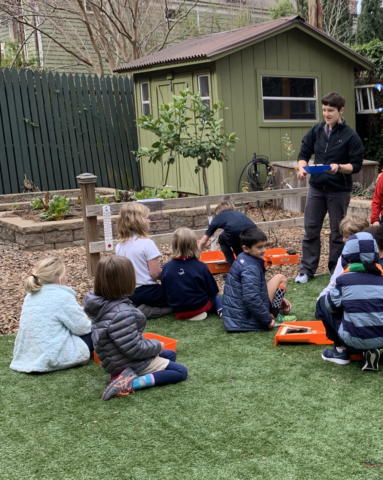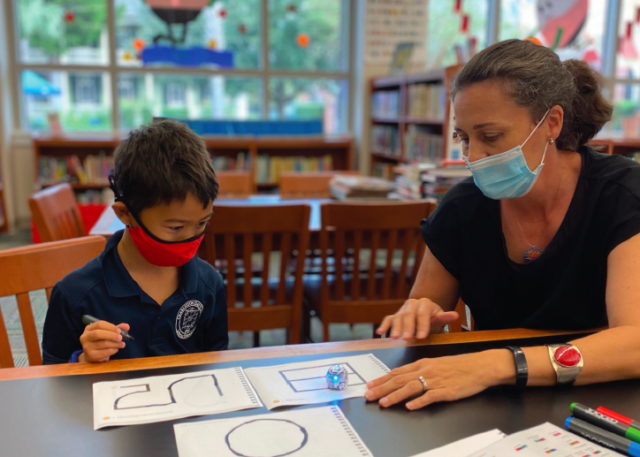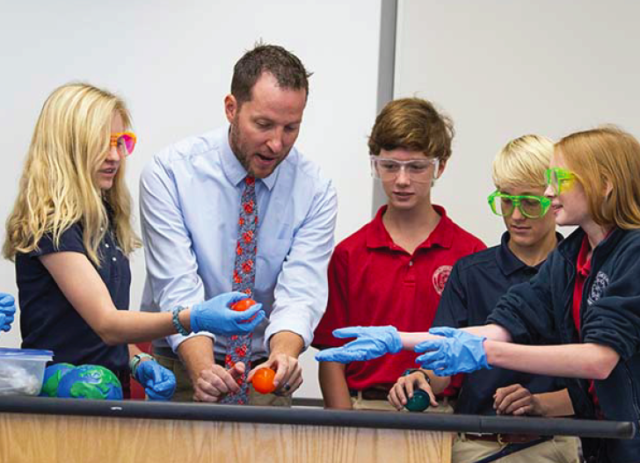Innovation Around Campus
Whether they are in the lab, the classroom, the library innovation space, the garden or observing the bee hive, our students are taught to be collaborative thinkers who confidently bring their independent thoughts to small groups and class discussions. Using the Next Generation Science Standards (NGSS), a skills-based science curriculum, our students are given the scientific toolbox to apply across disciplines. Our skilled, thoughtful and dedicated science teachers bring engagement and excitement to our science classes from Kindergarten all the way through eighth grade.
CDS Garden

Our CDS garden, complete with seven raised beds and a large turf green space is a popular spot on campus for science class and reading groups alike. A weather station complete with a rain gauge and a thermometer engages the younger students in reading weather tools. The compost system, run by Art teacher Kate Osmond, lives in the back corner behind the beds of native plants. Whether growing lettuce and vegetables to be used in our kitchen or sketching in their journals, CDS students treasure lessons and time spent in this urban garden.
Honeybee Hive
Charleston Day School has a honeybee hive in an observation wall of our science lab. The bees are a mesmerizing way to learn about bee culture, pollination and more. Click here to learn more about our honeybee hive!
Robotics & Coding
 Beginning in first grade technology class, students are exposed to early coding skills using their iPad and a laptop computer. Our creative technology teacher uses programs such as Tynker to teach students the basic building blocks of coding. Our dynamic librarian welcomes students to explore building materials as well as small robots such as Sphero balls and Ozobots during their time in our library innovation space. In the innovation space, students can be found coding and exploring with Ozobots based on line design and color. Coding is also offered in the upper grades as an elective.
Beginning in first grade technology class, students are exposed to early coding skills using their iPad and a laptop computer. Our creative technology teacher uses programs such as Tynker to teach students the basic building blocks of coding. Our dynamic librarian welcomes students to explore building materials as well as small robots such as Sphero balls and Ozobots during their time in our library innovation space. In the innovation space, students can be found coding and exploring with Ozobots based on line design and color. Coding is also offered in the upper grades as an elective.
Engineering Design Processes
 Engineering Design Processes are highlighted across grades so students work to develop their own models showing STEM in action. In second grade, the MacGyver project encourages students to think outside the box as they disassemble household simple devices and reassemble them into a new tool. In fourth grade, for example, students work to develop and practice a multitude of productive skills as they brainstorm, research, plan, engineer, test, improve and present a prototype of their very own. In eighth grade, students design robots with sensor technology to meet student-created challenges.
Engineering Design Processes are highlighted across grades so students work to develop their own models showing STEM in action. In second grade, the MacGyver project encourages students to think outside the box as they disassemble household simple devices and reassemble them into a new tool. In fourth grade, for example, students work to develop and practice a multitude of productive skills as they brainstorm, research, plan, engineer, test, improve and present a prototype of their very own. In eighth grade, students design robots with sensor technology to meet student-created challenges.




